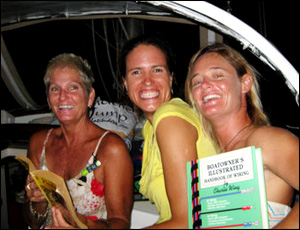Amanda and John Neal (s/v Mahina Tiare) were in the Samoan capital, Apia in September 2009 when a powerful tsunami generated by an undersea earthquake killed dozens and wiped out several villages in the Pacific islands of Samoa, American Samoa, and Tonga. Amanda described their experience in Earthquakes and Tsunamis – Part 1: Amanda Neal reports from Samoa (and Hawaii). Here, in Part 2, she reflects on the experience and offers suggestions for preparing for and responding to earthquake and tsunami alerts.
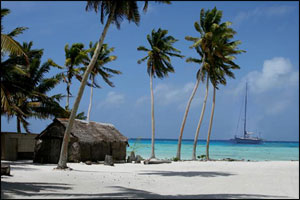 |
| 59% of tsunamis occur in the Pacific with 80% caused by earthquakes |
As sailors we need to be aware of the ever present threat of a tsunami.
By establishing emergency procedures for your crew and vessel along with knowing what to expect and do in the event of a tsunami it will be far less likely that you and your crew will become casualties and that your vessel will sustain damage.
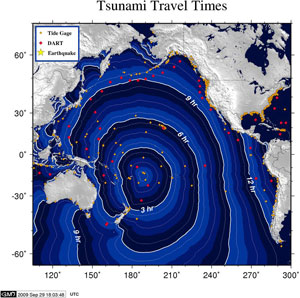 |
| Samoa Tsunami travel times (from the NOAA Pacific Tsunami Warning Center’s website) |
Time is the essence.
In the event of an earthquake, time is the essence as there may only be four minutes from the time of the earthquake to the arrival of a tsunami.
Tsunamis travel at 300-600 mph in the deep and open ocean so waiting to see if civil defense alarms sound after an earthquake is not wise.
When we experienced the earthquake in Apia, Samoa in 2009 the alarm sounded approximately 12 minutes later. Already the water was rapidly receding from Apia Marina where we were moored. At the instant the sirens went off, the tsunami was already coming ashore on the South side of the island in a series of waves that would claim over 130 lives. The quake was centered approximately 120 miles south of Samoa and about 100 miles West of American Samoa.
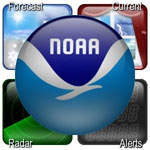 The NOAA Pacific Tsunami Warning Center is located at Ewa Beach, Hawaii. They have seafloor and coastal sensors located around and across the Pacific but after an earthquake it takes them at least 12-15 minutes to analyze data to determine if there is the potential for a tsunami.
The NOAA Pacific Tsunami Warning Center is located at Ewa Beach, Hawaii. They have seafloor and coastal sensors located around and across the Pacific but after an earthquake it takes them at least 12-15 minutes to analyze data to determine if there is the potential for a tsunami.
It is important to note that there can be as much as 300-400 miles between tsunami crests, so after the initial series of tsunami waves hit, the next set of waves may occur up to one hour later. There may be as many as nine consecutive wave sets.
This was the case in the 1960 tsunami that devastated Hilo, Hawaii, which had 35’ waves and claimed 61 lives.
Tsunamis can also wrap around islands.
Earthquake and Tsunami Awareness
Mid Ocean
As mid-ocean tsunami wave height is generally less than 3’, tsunamis are frequently unnoticed by mariners. However, here is an earthquake account from Brian Taylor aboard Kyogle.
I was approximately 100-150 miles from the September 29th [Samoan] earthquake center on and the effect on Kyogle was a bit scary.
She started shaking as if you were driving a car with all the wheels about to fall off.
I assumed that I had major trouble with my transmission system so stopped the engine and stopped the prop shaft from turning…..still shaking…checked the sails to see if they were flapping madly….
No problems there. The shaking stops and then restarts for a short while longer.
I was talking on my SSB radio a few minutes later and was then advised that a tsunami warning was in force.
When Ashore in a Coastal Location
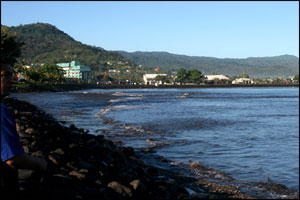 |
| Receeding and swirling water along the waterfront from the marina in Apia, Samoa |
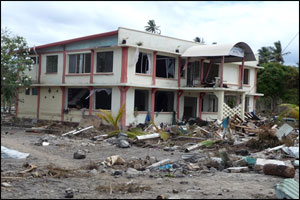 |
| Tsunami damage on the south coast of Upolu Island, Samoa – (Photo: Jill Josselyn) |
In any coastal location always note the tidal range and times.
If you ever see the sea level rising higher or receding lower than normal realize that this is the natural warning sign of an approaching tsunami.
If ashore, do not go out on the exposed reef or shore to collect fish, as locals frequently do. You must immediately run inland to high ground or get above the third floor of a sturdy building, if available.
Tsunamis have traveled .7 mile or further inland if the terrain is flat, so the option of going to the highest floor of a sturdy building may be safer than attempting to run inland.
In the Samoan tsunami the ground floors of many buildings were washed clean of everything and it would not have been possible to survive due to backwash of debris and swift currents, while above the third floor many buildings were relatively undamaged.
When Aboard
If you are docked and experience an earthquake or rapidly receding water, immediately start your engine, cut your docklines and motor at full speed to water deeper than 150’.
If the event occurs at night and/or it isn’t possible to safely leave the harbor, quickly leave your boat running for the hills or to a tall, substantial building.
At Anchor
If you are at anchor and experience an earthquake or rapidly receding water, immediately start your engine, raise your anchor and get to deeper water.
In the 2009 tsunami that hit Niuatoputapu, Tonga, friends aboard a 39’ sloop tried to raise anchor immediately after the earthquake but found their chain wrapped around a coral head, so they let out all of their chain.
When they saw the 13’ high surge come over the reef they kept the bow pointing into the wave while maintaining full forward throttle. They managed to survive the series of waves and swirling current with only stretched chain and a damaged windlass.
When leaving the boat, here are some priorities to quickly grab:
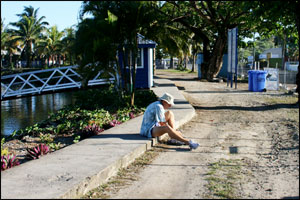 |
| John putting on his running shoes as we leave the marina (Apia, Samoa) |
- Passports, cash and credit cards
- Iridium satellite phone
- Cell phone
- VHF handheld radio
(this proved very helpful in Samoa) - Flashlights
- Knapsack
- Water bottle
- Granola bars or similar
- Necessary prescription medicines
- Running shoes
- Jacket
About Amanda Swan Neal
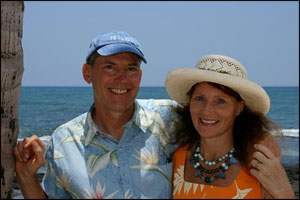 |
| John and Amanda Neal |
With over 237,000 miles, including Sydney-Hobart Races and numerous Cape Horn roundings, Amanda Swan Neal’s offshore sailing started before she was a teen with a family cruise through the South Pacific and on to Seattle.
Upon returning to New Zealand she became a sailmaker and rigger, completing the 1990 Whitbread Around the World Race aboard Maiden.
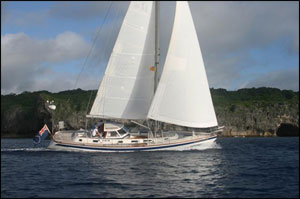 |
| s/v MAHINA TIARE |
In 1994 she fell in love with John Neal or perhaps Mahina Tiare II‘s passage to Antarctica.
Together they run Mahina Expeditions annually conducting 8 intensive offshore sail-training expeditions aboard their Hallberg-Rassy 46 Mahina Tiare III, presentations at major boat shows, and several Offshore Cruising Seminars.
Mahina Tiare‘s 2010 expedition circuit in will be in the South Pacific from New Zealand to Tahiti then weaving through the South Sea Isles to New Caledonia before returning to New Zealand.
Author of The Essential Galley Companion, Amanda writes the monthly “Galley Essentials” article for 48 North magazine and has contributed to Blue Water Sailing, Cruising World, Latitude 38 and Sail Magazine.
When not enlightening others with the joys of sailing Amanda can be heard Celtic step dancing or seen out paddling.
Related articles (on this website)
- Earthquakes and Tsunamis – Part 1: Amanda Neal reports from Samoa (and Hawaii)
- Amanda Neal’s April Seminars on Offshore Cruising
- Read what Amanda Swan Neal had to say in our Galley Advice from 18 Cruising Women article.
More info
- NOAA Pacific Tsunami Warning Center
- Mahina Expeditions website: www.mahina.com

